
The dream of Luna Rossa
Twenty years after the first America's Cup, the Italian team will return to New Zealand to chase the world's oldest trophy
March 6th, 2020
Luna Rossa Prada Pirelli Team / Studio Borlenghi
The story of Luna Rossa could be told as a sailing story: a boat that competes in the oldest sporting tournament in the world and almost wins in the midst of a thousand twists and turns. To tell it this way, though, the story wouldn't be complete. Luna Rossa was not only a hull and a crew: from TV regattas to catwalks, Luna Rossa was a contemporary pop phenomenon and as a wave that gradually moves away from its epicentre became the beginning of a new era for Italian sailing.
Born from the passion of Patrizio Bertelli and the genius of Miuccia Prada, Luna Rossa marked the Italian culture and aesthetics bringing into vogue the technical sailing apparel, from technical jackets to boat sneakers, making Italians dream with the element that most defines our country: the sea.
A THIN RED LINE
It was the beginning of 1997 when during a dinner with friends, Patrizio Bertelli and Miuccia Prada were annotating names on a sheet of paper. The goal was to find something that contrasted with Black Magic, the New Zealand boat that had won the last edition of the most important sailing trophy in the world, the America's Cup.
It's a special trophy, to explain it easily you could define it the Formula 1 of sailing as only the most advanced technologies and the best professionals are involved in it. The America's Cup, however, has a deeper appeal because its history goes back to 1851, and it's also full of rules that the winner (which is named defender) can change almost as he pleases, the participating teams organize a series of preliminary regattas that decides who will be the official challenger.
Evoking that rare moment of the day when the warm lights of the sunset illuminates the moon, the choice falls on Luna Rossa. The task was not easy: they needed to put together a crew from scratch, design a boat equipped with the best available technology and sail against experienced teams in the Gulf of Hauraki in New Zealand, the scene of the regattas planned at the beginning of the millennium. The sponsor of the boat would be Prada. In the spring of 1997, the team's training sessions began in Punta Ala, while designer Doug Peterson designed the hull following the rigorous parameters set by the last America's Cup winner. After two years of planning, on May 5, 1999, the godmother Miuccia Prada launched the first hull of Luna Rossa labeled ITA 45 in the presence of the parish priest of Punta Ala.
The boat was a masterpiece of technology and elegance: the hull was a sinuous blade made of carbon fiber, titanium and fiberglass while the grey and mysterious sails were made of a mix of carbon fiber and nylon, a very light, durable and extremely versatile fabric that at the time was mostly used for technical purposes. To enhance the silver livery of the hull on the bow and on the stern was placed a thin red line, replicated equally on the stray, the main sail.
Whenever the bow of Luna Rossa cleaveed the waves the first thing you could see was that thin red line, in short it became the symbol of the boat sparking the fascination of the public attracted by the technical elegance of the sail.
AUCKLAND'S NIGHTS
In the New Zealand waters of the Gulf of Hauraki, Luna Rossa's adventure begins in the best way: in October 1999 the Italian crew won all ten of the first regattas of the Round Robin, the first stage of the competition - the Louis Vuitton Cup - to select the team that will challenge the defender of the America's Cup, the very strong team of New Zealand.
During the semi-finals Luna Rossa had earned the nickname Silver Bullet and the sympathies of the public and insiders, enraptured by the speed of the hull and the charisma of the Neapolitan helmsman Francesco De Angelis, whose fierceness on the regatta field was balanced by a British style on the ground. During the semi-finals, amid a thousand twists including a dismasting, Luna Rossa took second place and access to the final that will be played against American One, the favorite team led by the moustachioed helmsman Paul Cayard.
After the initial enthusiasm, Paul Cayard won three races and took the challenge to 4 to 3, and Luna Rossa managed to avert the victory of the Americans by tying in the eighth race. The whole challenge is played in the last round. It took place on February 6, 2000, Luna Rossa started with a small advantage that increased constantly controlling the opponent, the regatta is won with 49th": it is the triumph of Luna Rossa in the Louis Vuitton Cup, For the second time in history, an Italian boat becomes the official challenger of the America's Cup. On the same night that De Angelis beat Paul Cayard, in Italy people went down to celebrate in the streets as if it the victory was of the Italian national football team.
The 30th America's Cup against Black Magic was another story. The Italian team came out exhausted from the challenge with American One and the hosts fresh and deep connoisseurs of the bizarre local breezes won the series 5-0. Despite the defeat, the myth of Luna Rossa had entered Italian popular culture carrying with it a thin red line.
THE OTHER AMERICA'S CUP
Since those nights in 2000, five more challenges have passed in which Luna Rossa has failed to win the honor of challenging the defender of the America's Cup. Complicit in regulation changes - including class change and the arrival of catamarans in the San Francisco 2010 edition - the America's Cup changed continents, protagonists and scenarios as Alinghi's Swiss team led by the entrepreneur alternated with dominance Ernesto Bertarelli, the American Oracle team and finally the New Zealanders again.
The arrival of the catamarans from 2010 radically changed the face of the America's Cup: the speed increased, the races became less strategic than the ACC class, the helmsmen had less interest in "marking" the opponent with the secptacular jibes and turns that had dominated the previous editions. Technology took over the human factor and Luna Rossa updated the crew's wardrobe: jackets and shorts were replaced by neoprene wetsuits and futuristic silver utility vests, helmets also appeared to protect the team from possible Injuries.
THE NEW CHALLENGE
Seven years after Luna Rossa's last candidacy, Patrizio Bertelli has taken on a new challenge: to participate in the 36th edition of the America's Cup which for an interesting game of fate will be held in Auckland, New Zealand, in March 2021.
The new Luna Rossa was launched at the Cagliari base by Miuccia Prada in October 2019, the challenge was launched.
Compared to 2000, the boats are AC75 flying monoclyses, technologically extraordinary compared to the ACC hulls of twenty years ago. They literally fly on the water - in technical language it's called foiling - traveling at more than 40 knots (over 80 kilometers per hour) compared to 11-12 in 2000. The nearly two-hour long regattas of the past now last about twenty minutes. It's a different way to sail, but on Luna Rossa's team there are also veterans like team director and skipper Max Sirena, a member of De Angelis' crew. The boat uniforms followed the path of technological advancement, however, taking up the basic grey tone to enhance the iconic red line.
Along with Prada there will also be Pirelli as the main sponsor of the new adventure of Luna Rossa, whose first regattas will take place in Cagliari from 23rd to 26th April 2020 during the America's Cup World Series (ACWS) and then move to England in Portsmouth in June 2020 and then to Auckland, New Zealand.
Nostalgic memory, Luna Rossa's dream comes back alive more than ever.
All Images are courtesy of Prada Luna Rossa, reproduction is strictly forbidden.
Credits to Luna Rossa Prada Pirelli Team/Studio Borlenghi









































.png)


.jpg)






























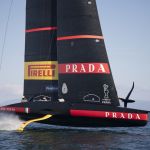














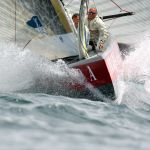
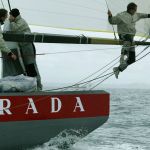

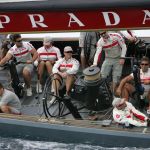
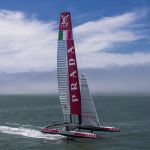















.jpg)

